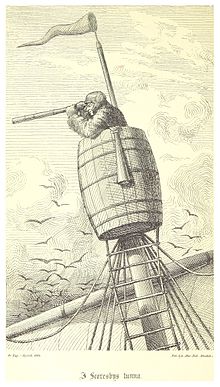Crow's nest


Acrow's nestis a structure in the upper part of themain mastof a ship or a structure that is used as a lookout point. On ships, this position ensured the widest field of view forlookoutsto spot approaching hazards, other ships, or land by using thenaked eyeor optical devices such astelescopesorbinoculars.It should not be confused with thetop,the platform in the upper part of each lower mast of asquare-riggedsailing ship.
History
[edit]The form of crow's nest used by theancient GreeksandRomanswas thecarchesium(Greek:καρχήσιον,karkhḗsion), named after a supposed similarity to a kind of ritual wine goblet.
According toWilliam Scoresby Jr.,the crow's nest was invented in the 19th century by his father,William Scoresby Sr.,a whaler and also an Arctic explorer.[1]However, Scoresby Sr. may simply have made an improvement on existing designs.[2]Crow's nests appear inEgyptian reliefsas early as 1200 BC and on eighth to seventh century BC representations ofPhoenician,Etruscan,andBoiotianships.[3]The crow’s nest disappears completely from depictions of ships after the seventh century, although the relationship between a raised vantage point and better visibility continued to be well understood.Theon of Smyrnawrote that by climbing the mast of a ship, one could see land that is invisible to those on deck.[3]
The first recorded appearance of the term was in 1807, used to describe Scoresby Sr.'s barrel crows nest platform.[citation needed]According to a popular naval legend, the term derives from the practice ofVikingsailors, who carriedcrowsorravensin a cage secured to the top of the mast. In cases of poor visibility, a crow was released, and the navigator plotted a course corresponding to the bird's flight path because the bird invariably headed "as the crow flies"towards the nearest land.[4]However, other naval scholars have found no evidence of the masthead crow cage and suggest the name was coined because Scoresby's lookout platform resembled a crow's nest in a tree.[5]
Since the crow's nest is a point far away from the ship'scenter of mass,rotational movement of the ship is amplified and could lead to severeseasickness,even in accustomed sailors. Therefore, being sent to the crow's nest was also considered a punishment.[citation needed]
Other uses
[edit]
In classicrailroadtrains,the box-like structure above thecaboose,thecupola,was also called the crow's nest. It served for observation of the whole train when in motion.[6]
Inhunting,a crow's nest is a blind-like structure where a hunter or a pair of hunters commit themselves to stalking game. A crow's nest is not a normal type of purchasable blind, but an improvised position, built by using locally discovered naturalflora(tree branches, moss, snow (during winter) or sand (during summer), etc.). A crow's nest works in most environments and provides a good lookout point (hence the name) when built in an elevated position like a hillside or top of a hill.
The term is sometimes usedmetaphoricallyfor the topmost structures in buildings,towers,etc. Such structures are often referred to as aWidow's walk.
References
[edit]- ^Scoresby, William (1828).Journal of a voyage to the northern whale-fishery; including researches and discoveries on the eastern coast of West Greenland, made in the summer of 1822, in the ship Baffin of Liverpool.A. Constable and Company. p. 470.
- ^Gillies, Robert Pearse (1826).Tales of a Voyager to the Arctic Ocean, Volume 2.H. Colburn. p. 11.
- ^abBay, Stephen (2013).The Encyclopedia of Ancient History(1st ed.). Blackwell Publishing Ltd. pp. 4715–4716.doi:10.1002/9781444338386.wbeah21223.ISBN9781405179355.
- ^"navy.mil".Archived fromthe originalon 2020-05-16.Retrieved2012-07-30.
- ^Word, World Of The Written (February 13, 2011)."World of the Written Word: THE CROW'S NEST".
- ^"A Brief History of the Train".Archived fromthe originalon 25 July 2010.
External links
[edit] Media related tocrow's nestat Wikimedia Commons
Media related tocrow's nestat Wikimedia Commons
